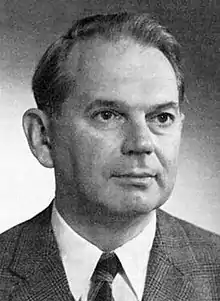Fritz Laves
Fritz Henning Emil Paul Berndt Laves[1] (27 February 1906 – 12 August 1978) was a German crystallographer who served as the president of the German Mineralogical Society from 1956 to 1958.[2][3][4] He is the namesake of Laves phases and the Laves tilings; the Laves graph, a highly-symmetrical three-dimensional crystal structure that he studied, was named after him by H. S. M. Coxeter.[5][6]
Fritz Laves | |
|---|---|
 | |
| Born | 27 February 1906 Hanover, Germany |
| Died | 12 August 1978 (aged 72) Laigueglia, Italy |
| Nationality | German |
| Alma mater | University of Zurich |
| Known for | Laves phase, Laves tilings, Laves graph |
| Awards | Roebling Medal (1969) |
| Scientific career | |
| Fields | Crystallography |
| Doctoral advisor | Paul Niggli |
Education and career
Laves was born in Hanover, the son of a judge and a descendant of architect Georg Ludwig Friedrich Laves.[1][4] He grew up in Göttingen, where his interests included piano music as well as collecting rocks and minerals.[4] He began his university studies in geology in 1924 at the University of Innsbruck, and continued at the University of Göttingen before moving to ETH Zurich for doctoral studies under Paul Niggli.[1][2][4]
In 1929 he took a faculty position under Victor Goldschmidt at Göttingen.[1][2] He tried unsuccessfully to prevent Goldschmidt from being dismissed in 1933,[4] and later had difficulty advancing through the German academic system under the Nazis because he was known as a protector of the Jews.[1] His research at this time largely concerned metals and intermetallic materials.[1][4] He was drafted into the German army in 1939, but returned to academia after the intervention of Paul Rosbaud, and instead worked on metallurgy for Hermann Göring during the war.[1][4] In 1944 he moved to the University of Halle as director of the Mineralogical Department, and then after World War II he became an ordinary professor at the University of Marburg, where he worked on disordered materials and two-dimensional structures.[1][2][4]
By 1948 he had agreed to be taken to America by the U. S. Navy, and began working with Julian Goldsmith at the University of Chicago.[1] At this time, his interests shifted again, to the study of feldspar, one of the minerals he had collected in his youth.[1][4] Despite having become highly Americanized, he found himself unable to resist an offer to return to ETH Zurich, in 1954, to fill the chair that had been left vacant by the death of his advisor Paul Niggli.[1] He remained in Zurich until his retirement in 1976.[2]
Laves was the editor of the journal Zeitschrift für Kristallographie between 1955 and 1978, which honoured him with a special issue in May 2006 commemorating the hundredth anniversary of his birth.[7][8] The issue was devoted to the crystal chemistry of intermetallic compounds and included two articles on Laves' contributions to crystallography.[9][10]
Laves was married to architect Melitta Druckenmüller, who assisted him with many of the illustrations in his publications.[4]
Awards and honors
Laves was awarded the Roebling Medal, the highest honor of the Mineralogical Society of America, in 1969.[1] He was a member of the Academy of Sciences Leopoldina, and a corresponding member of the Akademie der Wissenschaften und der Literatur and the Bavarian Academy of Sciences and Humanities.[4] He was also the recipient of an honorary doctorate from the University of Bochum.[4]
References
- Goldsmith, Julian R. (1970), "Presentation of the Roebling Medal of the Mineralogical Society of America for 1969 to Fritz Laves" (PDF), The American Mineralogist, 55: 541–544.
- Jagodzinski, H. (1979), "Fritz H. Laves, 1906–1978", Acta Crystallogr. A, 35: 343, Bibcode:1979AcCrA..35..343J, doi:10.1107/S0567739479000747
- Jagodzinski, Heinz (1985). "Laves, Fritz". Neue Deutsche Biographie (NDB) (in German). 14. Berlin: Duncker & Humblot. p. 3.
- Hellner, E. (1980), "Fritz Laves 27 February 1906 – 12.8.1978", Zeitschrift für Kristallographie, 151 (1–4): 1–20, doi:10.1524/zkri.1980.151.14.1, archived from the original on 15 September 2014, retrieved 1 December 2014
- Heesch, H.; Laves, F. (1933), "Über dünne kugelpackungen", Zeitschrift für Kristallographie, 85: 443–453, doi:10.1524/zkri.1933.85.1.443.
- Coxeter, H. S. M. (1955), "On Laves' graph of girth ten", Canadian Journal of Mathematics, 7: 18–23, doi:10.4153/CJM-1955-003-7, MR 0067508.
- Grin, Yuri (2006). "Editorial: Crystal Chemistry of Intermetallic Compounds". Z. Kristallogr. 221 (5–7): VI–VII. Bibcode:2006ZK....221D...6G. doi:10.1524/zkri.2006.221.5-7.VI.
- "Zeitschrift für Kristallographie – Crystalline Materials: Volume 221, Issues 5-7 (May 2006)". Walter de Gruyter. Retrieved December 26, 2016.
- Parthé, Erwin (2006). "Fritz H. Laves – 100 years young". Z. Kristallogr. 221 (5–7): 301–304. Bibcode:2006ZK....221..301P. doi:10.1524/zkri.2006.221.5-7.301.
- Fischer, Werner (2006). "Fritz H. Laves – An ideal for generations". Z. Kristallogr. 221 (5–7): 305–310. Bibcode:2006ZK....221..305F. doi:10.1524/zkri.2006.221.5-7.305.